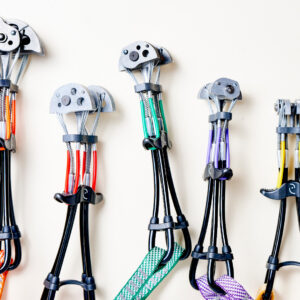Not All Cams Are Created Equal
When it comes to rock climbing cams, every trad climber has their go-to piece of gear. Some swear by Black Diamond Camalots, while others won’t leave the ground without their DMM Dragons. But there’s one cam that’s been making waves in the trad community—Totem Cams.
So, what makes Totem Cams different from traditional cams? Are they really more secure in tricky placements? And should you replace your entire rack with them?
In this head-to-head Totem Cams vs. traditional rock climbing cams comparison, we’ll break down the key differences and help you decide which cam to trust with your life.
Key Differences Between Totem Cams & Traditional Cams
Totem Cams have a unique design that sets them apart from most spring-loaded camming devices (SLCDs). Here’s how they stack up:
| Feature | Totem Cams | Traditional Cams (BD, DMM, Metolius, etc.) |
|---|---|---|
| Lobe Engagement | Direct Loading System (DLS) = More force on lobes | Axle-based force distribution |
| Narrow Head Width | ✅ Yes (Fits in tight cracks) | ❌ No |
| Flexible Stem | ✅ Yes (Reduces walking) | ✅ Some, but often stiffer |
| Two-Lobe Placements | ✅ Yes (Works in pin scars, aid placements) | ❌ No |
| Holding Power in Marginal Placements | ✅ Superior | ❌ Less reliable in funky cracks |
| Ease of Cleaning | ✅ Easier due to narrow profile | ❌ Can get stuck in deep placements |
| Best For | Flared cracks, pin scars, horizontals, tricky placements | All-around climbing, bomber cracks |
Verdict: Totem Cams are best for climbers who need extra security in tough placements, while traditional cams offer a more general-purpose design for standard cracks.
Why Totem Cams Excel in Tricky Placements
Direct Loading System (DLS) = More Secure Holds
Unlike traditional cams that distribute force through the axle, Totem Cams use Direct Loading—which means the force is applied directly to the lobes. This results in:
- Better grip in slick rock types (like Yosemite granite)
- Stronger placements in flared or shallow cracks
- More holding power in pin scars and marginal placements
Real-World Example: If you’ve ever placed a cam in a flared, insecure crack and questioned whether it would hold, Totem Cams solve this problem.
Narrow Head Width = More Placement Options
Standard cams have wider head profiles, which means they don’t fit in tight spaces.
Totem Cams have one of the narrowest head widths on the market, allowing them to:
- Fit into thin cracks where other cams won’t go
- Be placed deeper for extra security
- Work better in horizontal placements
Bonus: This also makes them easier to clean after a fall—less chance of getting stuck!
Flexible Stem = Less Walking, More Stability
One common issue with traditional rock climbing cams is that they can “walk” into the crack due to rope movement, making them:
❌ Harder to retrieve
❌ More likely to shift into a weaker placement
Totem Cams have an ultra-flexible stem, reducing the chances of walking and keeping the placement where you set it.
Best Use: On wandering trad routes where rope drag could cause traditional cams to shift.
 Two-Lobe Loading for Aid & Marginal Placements
Two-Lobe Loading for Aid & Marginal Placements
Traditional cams require all four lobes to engage to be effective. If two lobes aren’t gripping, the cam is useless.
Totem Cams are the only cams that can hold weight on just two lobes, making them:
- Stronger in aid climbing placements
- Better for flared cracks or pin scars
- More versatile in funky rock formations
This is why big-wall climbers and aid climbers love Totem Cams!
When Traditional Cams Might Be a Better Choice
While Totem Cams excel in marginal placements, there are some situations where traditional rock climbing cams might be the better choice:
Price & Availability
- Totem Cams are more expensive than many traditional cams.
- Standard Black Diamond Camalots and DMM Dragons are easier to find.
If you’re on a budget, starting with traditional cams and adding Totem Cams for tricky placements is a solid strategy.
Wider Expansion Range in Double Axle Cams
- Black Diamond Camalots and DMM Dragons have a double axle design, meaning they cover a wider range per size.
- This means you need fewer cams to cover the same range of crack sizes.
Best For: If you want a smaller, more efficient rack for general trad climbing, traditional double-axle cams are a great option.
Durability in Heavy Use
- Totem Cams are highly specialized, but their Direct Loading System relies on thinner materials.
- Traditional cams are often bulkier and heavier but may last longer with repeated abuse.
If you’re climbing in desert sandstone or placing gear on a daily basis, traditional cams may hold up better over time.
Which Cams Should You Get? The Verdict
It doesn’t have to be an either-or decision—many climbers use a mix of Totem Cams and traditional cams to cover different scenarios.
For Beginner Trad Climbers:
- Start with a set of Black Diamond Camalots or DMM Dragons for general climbing.
- Add a few Totem Cams for tricky placements.
For Experienced Trad Climbers:
- Consider doubling up on Totem Cams in key sizes (Purple, Yellow, Blue).
- Use traditional cams for straightforward cracks.
For Aid Climbers & Big Wall Climbers:
- Totem Cams are the clear winner for aid climbing.
- Their two-lobe loading makes them essential for technical aid routes.
Final Thoughts: Which Cam Should You Trust?
🔹 If you want the best rock climbing cam for funky placements, go Totem.
🔹 If you need a versatile, budget-friendly option, go traditional.
🔹 For the best of both worlds? Build a rack with both!
Want to upgrade your trad rack? Check out our selection of Totem Cams and find out why climbers trust them in the toughest conditions!
